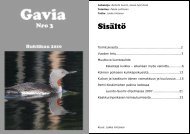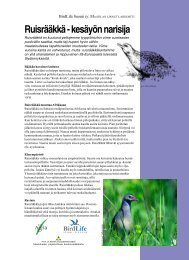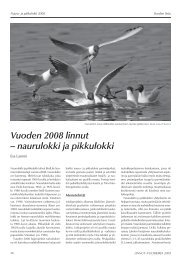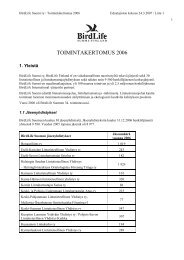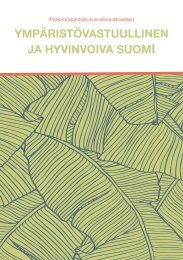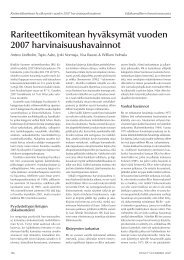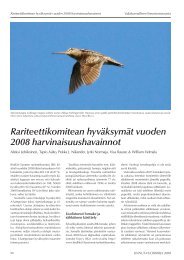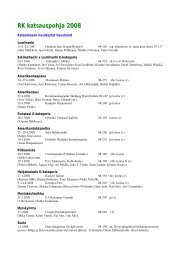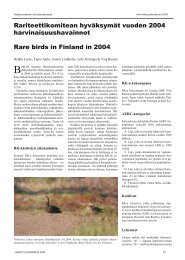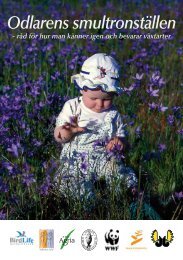Metsiensuojelun tavoitteita 2000-luvun suomessa - BirdLife Suomi
Metsiensuojelun tavoitteita 2000-luvun suomessa - BirdLife Suomi
Metsiensuojelun tavoitteita 2000-luvun suomessa - BirdLife Suomi
- No tags were found...
Create successful ePaper yourself
Turn your PDF publications into a flip-book with our unique Google optimized e-Paper software.
Summary: Social and Economic Effects of the ProposedForest Conservation ProgrammeBy Marcus WalshA very large majority of Finns – 86 per cent – wish to see more forest protected, a fact reflectedin many different studies. The amount of forest citizens think should be protected amountsto between 5–10 per cent of forest land. One Finn in five aged 15–74 visits a national parkannually at least once. More than half the citizens are prepared to pay an annual fee for forestconservation and recreational use of at least eight euros (currently there are no such charges).Equally of note, a third of private Finnish forest owners support a reduction in current logginglevels if this is required for biodiversity to be preserved.In terms of acquisition costs to non-governmental landowners the proposed forestconservation programme in this volume would cost around 96 million euros per year in2003–2010 and 134 million euros in 2011–2020. As a comparison, Finnish government supportto the commercial private forest sector in 2001 has been estimated at ca. 223 millioneuros (Figure 8.10). Of this, only 4,2 million euros was for environmental works. Support tothe commercial forest sector should be phased out or environmental support monies raisedto the same level as commercial ones.The proposed forest conservation programme could be financed e.g. by a small biodiversitylevy on logged and imported timber. Currently virtually all biodiversity conservationcosts are borne by the state, while most of the problems are caused by the commercial forestsector. Air and water pollution issues have earlier been addressed with similar levies to payfor the costs of mitigation.Of forests south of Lapland, 13 per cent or around two million hectares are on average100 years old or more. Partly due to this reserve of mature forest, on a national scale theproposed conservation programme would be unlikely to cause a dearth of timber for industrybefore 2010, except to some sawmills dependent on local quality timber supplies. In the longerterm, when the whole conservation programme has been realised, the greatest sustainable annualtimber harvest would gradually decline by an estimated 6–11 per cent. Annual harvestingrates greater than currently practised would nonetheless still be possible (see figure 8.2).Automation has rapidly reduced the labour force of the Finnish forest industry sector,even though annual timber harvesting rates increased sharply in the same period (figure 8.2).Forest conservation effects on forest sector job losses have been minimal. In contrast, therapid rise of nature tourism has demonstrated that in some cases forest conservation makesgood sense economically as well as ecologically. Recent employment statistics and trendsin the forest and tourist industries show that the forest conservation programme proposedhere, if appropriately designed, would probably create more jobs than it forfeits. Of particularimportance is to create in southern Finland more forested national parks of sufficient sizeto be of interest to large numbers of visitors. In addition to tourism, ecological restorationworks within protected forest areas can be expected to generate a significant number of jobsfor forestry professionals. Other important ways to improve employment in the forest sectorare to process timber further, and developing the use of wood residues for power production.Particularly the former measure, e.g. to export furniture and printed matter rather than sawntimber and paper, has been neglected in recent Finnish national forest sector developmentprogrammes. For example, Finland currently imports twice times as much wood furniturefrom Denmark as it exports, although the latter is totally dependent on imported raw timber.101



